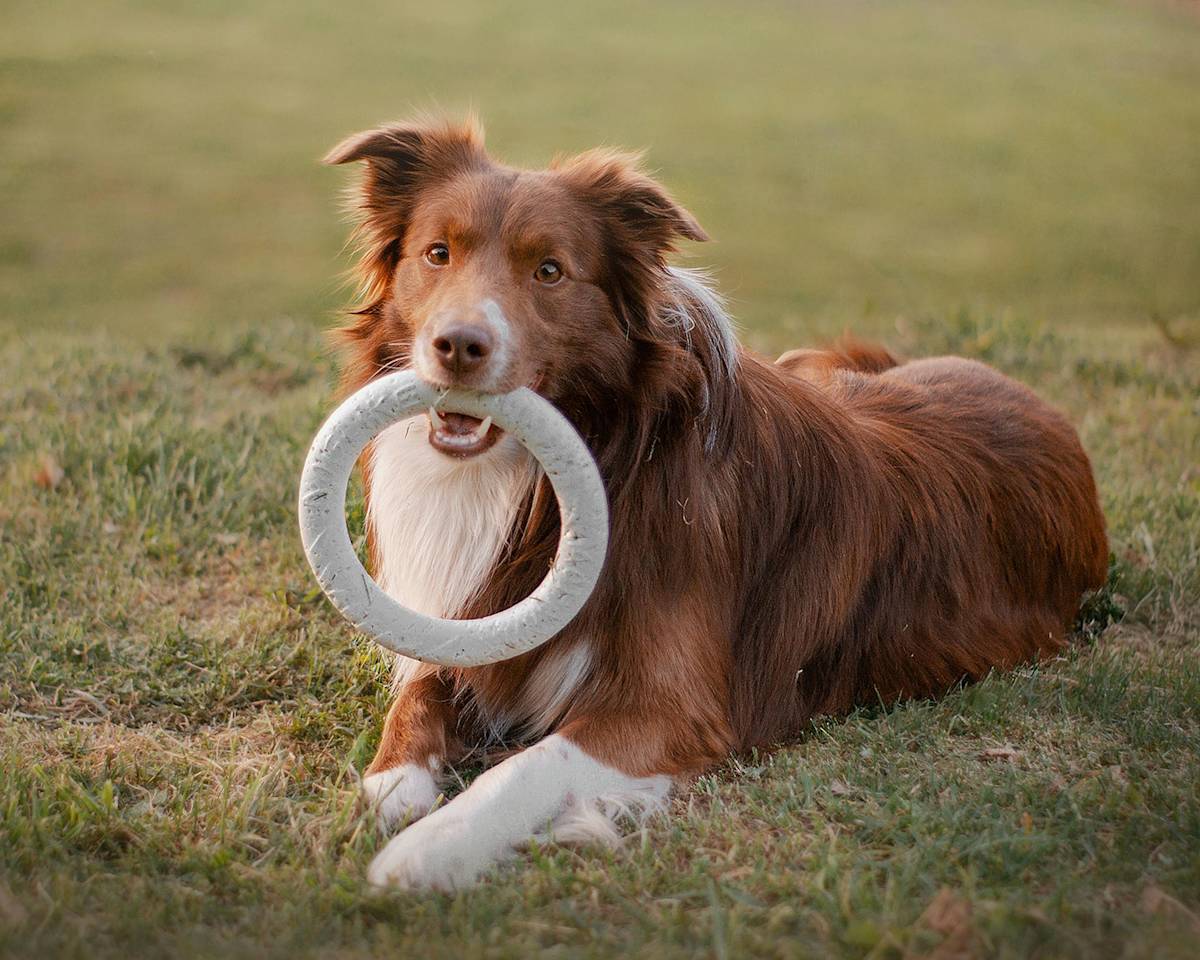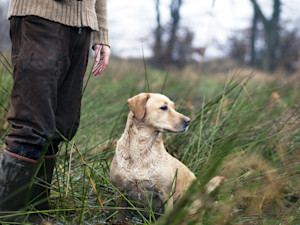Is Your Dog As Smart As You Think They Are?
Turns out, there’s more to being a dog genius than being good at tricks

Share Article
As pet parents, we tend to either joke that our dogs have one brain cell or proclaim that they’re the canine equivalent of Einstein, without realising there’s a whole grey area in between. A grey area about grey matter, if you will.
Psychologist and leading canine researcher, Stanley Coren, has done loads of studies on dogs, and he reckons that canine cognitive abilities are akin to that of a two to two-and-a-half-year-old childopens in new tab. His research shows that the average dog can learn 165 words, with the highest achievers able to remember a whopping 250 words. Pretty impressive, huh?
Dogs have also been shown to be able to count and quantify things (tested with foodopens in new tab, obvs), solve spatial problemsopens in new tab (like figuring out the fastest route to their favourite chair or learning how to open a door), and – you probably already know this – manipulate humans and other dogsopens in new tab into getting what they want.
Don’t recognise your dog in any of the above and are convinced they’re a bit of a dunce? Well, I’m here to tell you why that’s not the case – read on to find out about the complexities of dog intelligence, and why recall and learning to ‘sit’ are just a tiny piece of the puzzle. By the time you’ve finished reading, you’ll be looking at your dog in a whole different light, trust me…
How much do you spend on your pet per year?
Intelligence comes in many forms
In 1983, psychologist Howard Gardneropens in new tab proposed the theory of human multiple intelligence in his book Frames of Mind: The Theory of Multiple Intelligences. He argues that human intelligence can be split into eight categories – linguistic, logical-mathematical, spatial, bodily-kinesthetic, musical, interpersonal, intrapersonal and naturalistic. Similarly, intelligence isn’t one-dimensional when it comes to our furry friends. In Coren’s groundbreaking 1994 book, The Intelligence of Dogs, the psychologist applies three main types of canine intelligenceopens in new tab:
Instinctive intelligence
A dog’s innate ability to perform tasks that their specific breed was bred for, without being trained to do so – eg, herding, guarding or retrieving.
Adaptive intelligence
This is what a dog learns to do themselves when problem-solving – eg, figuring out how to sneak through a fence, escape their crate or find a treat hidden in a toilet roll.
Working intelligence
Humans shape this type of intelligence; it encompasses everything a dog learns to do via training – eg, learning cues, and, crucially, responding correctly to these cues.
However, as with humans, there are additional types of canine intelligence, according to Nina Fotara, a holistic gun dog trainer and founder of Confident Canineopens in new tab: “Dogs also have social, emotional, sensory, spatial, energetic, resilience, physical and task intelligence.”
In fact, studies show that dogs are able to recognise and respond to our facial expressionsopens in new tab, notice when someone is being horrible to their pet parentopens in new tab and understand our tone of voiceopens in new tab, showing that social intelligence may be hugely overlooked when judging a dog’s smarts. Let’s be real – research shows that we’re not as good at reading our dogs’ emotions as we think we areopens in new tab, so who are we to call them stupid?
Common misconceptions about dog intelligence
The human education system places utmost value on linguistic and logical-mathematical intelligence, often leaving kids who lack traditional academic abilities feeling like they’re ‘lacking’, even though they might excel in the arts, be a star athlete or have amazing social skills.
A similar thing happens with dogs. “Most pet parents only ever pay attention to working and obedience intelligence, so there’s a whole world of guardians believing their dog is ‘stupid’ because they don’t sit fast in a village hall on a Tuesday night,” Fotara laments. “Intelligence isn’t a single lane. It’s a whole landscape.”
Here are some important things to consider before writing your dog off as a dimwit.
Obedience ≠ intelligence
While we don’t love the word ‘obedience’ (it’s a bit dated and implies a power dynamic we’re not into), it’s the language the research uses, so bear with us. Just because your dog ignores your commands and looks at you with glazed eyes doesn’t mean they’re an idiot. “A dog who doesn’t fly through obedience drills might instead be phenomenal when it comes to instinctive work, emotional presence, environmental reading or scenting,” says Fotara. “So-called ‘stubbornness’ can actually be a sign of independence.
For example, many hunting dogs have actually been bred for independence to enable them to hunt without human direction, like Afghan Hounds. Afghans are brilliant, but this brilliance doesn’t look like, ‘Yes, what next?’ obedience. It looks like autonomy, discernment and a deep connection to their instincts.” Berating a dog for doing exactly what we’ve bred them to do? How very human of us.
Breed stereotypes vs individual variation
This leads nicely onto Coren’s famous list of dog breeds that rank from most intelligent to least intelligentopens in new tab (with Border Collies at the top and the aforementioned Afghan Hounds at the bottom), though Fotara points out the flaws in this list. She says it was compiled with results from obedience judges and is solely based on working and obedience intelligence, when as you’ve just read, the reality is much more complex than that.
“Breed and Coren’s categories do give us a broad outline, but the individual dog, their breeding lines (which affects their instinctive abilities), their history, health and emotional world will always tell the real story of where their intelligence lies and how it shows up,” she explains.
Coren claims that 51 percent of a dog’s intelligence is genetic, while 49 percent is shaped by their environment, so it’s often us humans who are the problem if we haven’t given our dogs the right environment for them to thrive in. “A stressed, overwhelmed or under-stimulated dog will always look less capable than they truly are,” Fotara tells me. “Lack of early and ongoing socialisation, unclear communication from the guardian and inconsistent training environments can all make a dog appear ‘slow’ or ‘stubborn’ when, in reality, they’re simply confused or overloaded.”
There’s no such thing as a ’dumb’ dog
Dogs, like humans, are complex animals with individual quirks, and us pet parents are often guilty of trying to squeeze triangle-shaped dogs into our square-shaped lives. Just because a dog doesn’t behave the way we want them to doesn’t mean they’re stupid.
“If we judge a dog on a task that doesn’t match their strengths, instincts, genetics, temperament or learning style, of course they’ll look like they’re failing,” explains Fotara. “Every dog shines somewhere – a dog who struggles in one area will often excel in another when given the right environment, clarity and support. So no, there’s no such thing as a stupid dog, only misunderstood dogs, mismatched expectations, and humans who haven’t yet learned how to recognise the brilliance in front of them.”
Making the most of your dog’s brain
Recently, I made some DIY enrichment toys to keep my dogs entertained as Sherlock has hurt his leg and isn’t allowed on long walks. I was surprised to see that my other dog, Lucy, struggled to find treats hidden in cardboard boxes, even when allowed to sniff them and being shown where they were. I’ve always thought of her as pretty smart as she’s a whizz at manipulating humans, but this game highlighted her lack of problem-solving abilities. However, Fotara assures me that she’s not stupid (phew).
“There could be lots of reasons for Lucy struggling,” she explains. “Has she ever been taught how to search? Some dogs are naturally brilliant at following scent patterns, airflow and ground scenting, while others genuinely don’t know how to begin. Medications, pain, age and health can also affect how dogs use their noses. And remember, her sense of smell has nothing to do with her intelligence, but how she searches does – if that instinctive intelligence isn’t naturally there, it can be taught.”
With dogs like Lucy, Fotara says the real magic comes when you build their confidence and teach them how to problem-solve in small steps, discovering what’s fun and rewarding for them, not what we think should be fun. Whether it’s enrichment games or training, Fotara suggests taking a deep breath, going back to basics and observing what lights up your dog, before building on that: “Everything will then become easier – the training flows, the confidence grows and the dog’s true intelligence comes alive in ways we often didn’t expect.”
So, in Lucy’s case, I’ll let her get the hang of finding treats in toilet roll tubes before attempting to hide them in boxes or under rugs again. (Slow and steady wins the race and all that.)
Does it really matter if your dog isn’t a genius?
I don’t love my Lucy any less for not picking up games easily, just as my parents didn’t disown me for being rubbish at maths. I know that Lucy’s brilliant at other things (unfortunately, one of these is hunting wildlife…) and her happiness and our emotional bond isn’t affected by her inability to sniff out dried chicken bites in an old pizza box.�
I have infinite gratitude for the friends and colleagues who work with my quirks (disorganisation, distraction and terrible time-keeping) rather than against them, so why can’t I do the same for my dogs?
Loving your dog just as they are, matching your expectation to their strengths, and supporting them in a way that suits them is the first step to seeing progress and ensuring your relationship stays happy and healthy. After all, there’s no such thing as a stupid dog, but there is such a thing as an ignorant human. But thankfully, that’s something we can all work on.
References
“Smarter Than You Think: Renowned Canine Researcher Puts Dogs’ Intelligence on Par With 2-Year-Old Human.opens in new tab” apa.org, 8 Aug. 2009.
” How Do Dogs Quantify Things?opens in new tab “Canine Cognition and Human Interaction Lab | Nebraska. 24 Apr. 2025.
Iotchev, Ivaylo Borislavov, et al. “Cognitive and Sensory Capacity Each Contribute to the Canine Spatial Bias.” Ethology, vol. 130, no. 2, Nov. 2023, p. e13423. https://doi.org/10.1111/eth.13423opens in new tab.
Kaminski, Juliane, et al. “Evolution of Facial Muscle Anatomy in Dogs.opens in new tab” Proceedings of the National Academy of Sciences, vol. 116, no. 29, June 2019, pp. 14677–81.
Morgan, H. “Howard Gardner’s Multiple Intelligences Theory and his Ideas on Promoting Creativity.opens in new tab” In F. Reisman (Ed.), Celebrating Giants and Trailblazers: A-Z of Who’s Who in Creativity Research and Related Fields, 2021, pp.124–141.
Coren, Stanley. “The Intelligence of Dogs: Canine Consciousness and Capabilities.” Medical Entomology and Zoology, 1994.
Albuquerque, Natalia, and Briseida Resende. “Dogs Functionally Respond to and Use Emotional Information From Human Expressions.opens in new tab” Evolutionary Human Sciences, vol. 5, Dec. 2022, p. e2.
“Dogs Avoid People Who Behave Negatively to Their Owners.opens in new tab” KYOTO UNIVERSITY, 24 June 2015.
Lehoczki, Fanni, et al. “Family Pigs’ and Dogs’ Reactions to Human Emotional Vocalizations: A Citizen Science Study.opens in new tab” Animal Behaviour, vol. 214, July 2024, pp. 207–18.
Guo, Kun, et al. “Category-dependent Contribution of Dog Facial and Bodily Cues in Human Perception of Dog Emotions.opens in new tab” Applied Animal Behaviour Science, vol. 280, Oct. 2024, p. 106427.
Gewirtz, Elaine Waldorf. “Study Measuring Canine Intelligence Ranks Breeds as the Smartest.opens in new tab” American Kennel Club, 13 Mar. 2024.

Lisa Bowman
Lisa is a writer whose work has been featured in the likes of Stylist, Metro and The Guardian. She spends her days at a computer so she can bankroll her two rescue dogs, who may or may not be The Cutest Dogs in the World.
Related articles
![dogs running with a football]()
5 Types of Enrichment Every Dog Needs
A well-enriched dog is a happy dog – and who wouldn’t want that?
![Gun dog in a field]()
Born This Way: How to Meet The Needs of Your Dog’s Breed
Different breeds need different things...
![profile portrait of grumpy a ginger dog, inside on a golden retro velvet armchair]()
Your Grumpy Dog Is Very Smart – Science Says So
This study found that cranky pups are actually very fast social learners
Cats vs Dogs: Exploring Feline Intelligence and Canine IQ
A common (if not silly) question with a complicated answer






